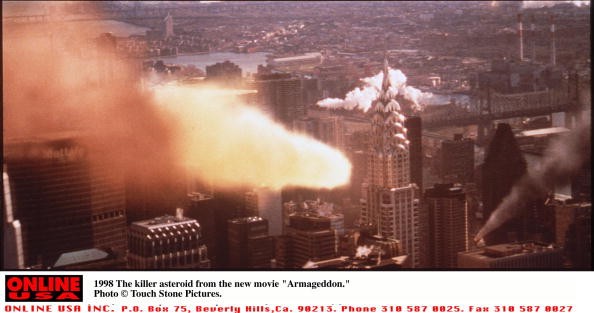Happy Asteroid Day: 5 Facts You Need To Know About Asteroids
| KJ Belonio | | Jul 01, 2015 06:09 AM EDT |
(Photo : Getty Images /Handout) In celebration of the first Asteroid Day on June 30, scientists took part in a discussion about the capability of the Earth to defend itself against the potential danger of a major asteroid.
In celebration of the first Asteroid Day on June 30, scientists took part in a discussion about the capability of the Earth to defend itself against the potential danger of a major asteroid.
The "Happy Asteroid Day" aims to provide information and awareness on the hazards asteroids can bring once they hit the Earth. Though an apocalyptic scenario seems to be overrated, future catastrophic events can still ensue. And in order to push space-related risks back into the public consciousness, astronauts and scientists collaborated and held a debate on Earth's readiness to defend itself from the threats of a cataclysmic asteroid impact, Time magazine reported.
Like Us on Facebook
"The largest asteroids are fascinating to observe, while the hazardous ones need to be watched while defenses are being conceived," astronomer Bob Berman told the press.
Aside from the discussion, which was hosted by Slooh Community Observatory, a live telescope view Icarus, the most recent near-Earth asteroid that was slightly over a half-a-mile long and passed by within 5 million miles on June 16, was also included.
Meanwhile, to mark the first Asteroid Day, here are 5 interesting facts you need to know about asteroids.
1. Asteroids are small, inactive and rocky solar system bodies that populate interplanetary space out to the orbit of Jupiter, NASA revealed. They are often grouped by their composition.
2. Asteroids, which are sometimes called minor planets — a general term applied to solar system bodies smaller than moons, are mainly made of materials left over from the formation of the inner solar system words. According to Space Facts, most of them orbit the Sun between Mars and Jupiter, although there are groups of them that orbit closer.
3. Asteroids come in three composition classes, Universe Today has learned. The C-types (chondrites) are made of clay and silicate rocks. While the S-types are the so-called "stony" asteroids and are made mostly of silicate rocks and nickel-iron mixtures whereas the M-types are metallic nickel-iron. These classifications indicate how far from the Sun they are formed in the early solar system.
4. Although the most dangerous asteroids are extremely rare, they're still capable of global disaster that can be more than a quarter-mile wide. Space.com reported researchers have estimated that such an impact would raise enough dust into the atmosphere to effectively create a "nuclear winter," severely disrupting agriculture globally.
Moreover, NASA officials said large asteroids strike Earth only once every 1,000 centuries on average. While smaller asteroids, which are believed to strike Earth every 1,000 to 10,000 years, could destroy a city or cause devastating tsunamis.
5. In line with the celebration of the Asteroid Day, Newsweek noted that June 30 was selected because it marks the anniversary of the Tunguska event more than a century ago. It was when an asteroid slammed into the Earth's atmosphere and disintegrated over Siberia, devastating hundreds of miles of forest. Fortunately, it had low population density thus, there were no deaths or injuries documented.
Unlike the Tunguska event, the 2013 Chelyabinsk meteor in Russia created a shock wave that injured 1,200 people. It was also an event that thrust space-related dangers back into the public consciousness.
In other news, scientists have warned that Britain is at risk from an asteroid tsunami that could kill hundreds of thousands of people living in coastal regions. As per The Telegraph, the University of Southampton researchers have developed a software, which could predict the impact "corridors" of known asteroids and calculates the risk to communities if they struck.
Furthermore, the new maps suggest a wide asteroid risk zone running through Europe, passing directly over Scandinavia, Germany, France and Spain. While the U.S. is largely unaffected, Florida and Louisiana could be hit. South Australia, on the other hand, is particularly at risk with several asteroid paths crossing the Lake Gairdner National Park and leading to Queensland.
Asteroid collision is within the realm of possibility and is something that governments and the public should be prepared for. And to protect the Earth from future apocalyptic scenes, the American Museum of Natural History has released a video, entitled "Deflecting Asteroids."
TagsAsteroid Day, Facts, asteroid, Asteroid Facts, Science
©2015 Chinatopix All rights reserved. Do not reproduce without permission
EDITOR'S PICKS
-

Did the Trump administration just announce plans for a trade war with ‘hostile’ China and Russia?
-

US Senate passes Taiwan travel bill slammed by China
-

As Yan Sihong’s family grieves, here are other Chinese students who went missing abroad. Some have never been found
-

Beijing blasts Western critics who ‘smear China’ with the term sharp power
-

China Envoy Seeks to Defuse Tensions With U.S. as a Trade War Brews
-

Singapore's Deputy PM Provides Bitcoin Vote of Confidence Amid China's Blanket Bans
-

China warns investors over risks in overseas virtual currency trading
-

Chinese government most trustworthy: survey
-

Kashima Antlers On Course For Back-To-Back Titles
MOST POPULAR
LATEST NEWS
Zhou Yongkang: China's Former Security Chief Sentenced to Life in Prison

China's former Chief of the Ministry of Public Security, Zhou Yongkang, has been given a life sentence after he was found guilty of abusing his office, bribery and deliberately ... Full Article
TRENDING STORY

China Pork Prices Expected to Stabilize As The Supplies Recover

Elephone P9000 Smartphone is now on Sale on Amazon India

There's a Big Chance Cliffhangers Won't Still Be Resolved When Grey's Anatomy Season 13 Returns

Supreme Court Ruled on Samsung vs Apple Dispute for Patent Infringement

Microsoft Surface Pro 5 Rumors and Release Date: What is the Latest?










